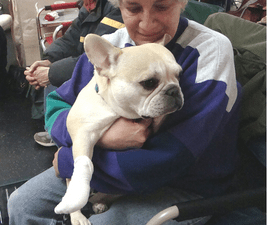The first time we saw bloody footprints wherever Golly walked, we panicked. Clearly we had a dog emergency on our hands. It was before seven in the morning, so we raced to the emergency vet. A huge vet bill later, she was returned to us sporting a bandage with a little pink gauze heart. She’d torn a nail. She was fine.
The next time we saw bloody footprints from Golly, we washed her foot, slapped a bandage on, and waited for our regular vet’s office to open. Experience is a great teacher and we’d learned our lesson. Especially since Golly was impatient for her breakfast and unfazed by her new broken nail.
Use your common sense
Owning a dog is a lot like being the parent of a perpetual toddler. With your first, you worry all the time. Not only about what happens, but whether you’re getting it right. By the time your second, third, etc. come along, you’re an old hand and learn to relax more.
Common sense is the best reaction in most dog emergency situations. The first time your dog starts “reverse sneezing” and is gasping for air, your first instinct might be to race for help. The common sense resolution is to get your dog to open his/her mouth and breathe that way. Just blocking the dog’s nostrils usually gets them to open their mouth. A few deep breaths later, they’re back to normal, like nothing happened. Reverse sneezing is one of those “looks worse than it is” issues.
If your dog is bleeding from a cut or scrape, clean it and take a look. If the injury is one you wouldn’t see a doctor for, chances are your dog doesn’t need to, either. Treat it just like you would if it was yours. Same thing with stomach upsets. If it’s a one-time incident and your dog is acting normally, do the same kind of thing you’d do for yourself.
Keep a dog emergency kit
That being said, you can’t use all the same first aid products on dogs that you do for yourself. Latex bandages just won’t work on fur. Get a storage bin and collect the first aid items you may need for dog emergency incidents. The best-equipped dog first aid kits would have:
- Gloves
- Antiseptic Wipes
- Hydrogen Peroxide (for either cleaning wounds or getting the dog to vomit)
- Antibiotic spray or ointment
- Burn Gel with Lidocaine
- Eye Wash
- Sterile Gauze Pads
- Self-Adhering Bandage Wrap
- Cotton Swabs
- Instant Cold Pack
- Towel
- Oral Syringe
- Digital Thermometer
- Scissors
- Tweezers
- Flashlight
- Muzzle
- Canine 1st Aid Manual
Before you use any product on your dog, make sure it’s safe for canines. On the advice of our veterinarian, we also keep Benadryl in our kit. Ever since our Boston Terrier Daemon decided eating a bee every spring was his job. The first time, we ran to the vet. After that? Gave him a Benadryl and kept an eye on him to make sure the swelling subsided.
It’s also a good idea to find a class or seminar about dog First Aid. Humane societies sometimes have them, or some dog clubs. In the picture, Teddy wasn’t thrilled about Hope practicing her bandaging technique at our dog training club’s seminar on dog First Aid.
Sometimes panic is right
There are times when a trip to emergency is called for. If you’re not sure what’s wrong, your dog is obviously in pain, having a seizure, has pale gums, unconscious, unable to walk, etc., get help immediately. It’s better to make an unnecessary trip than to risk your dog’s health.
Like the time when we came home from work and Daemon shrieked in pain when we touched him. Off to the emergency vet, in the dark, in a blizzard. It turned out he had gas. He was fine. But in all honesty, if any of our dogs screamed in pain at a touch – we’d still run to the vet with a dog emergency.
Enjoyed this post? Click here to sign up for the weekly newsletter and never miss another!















